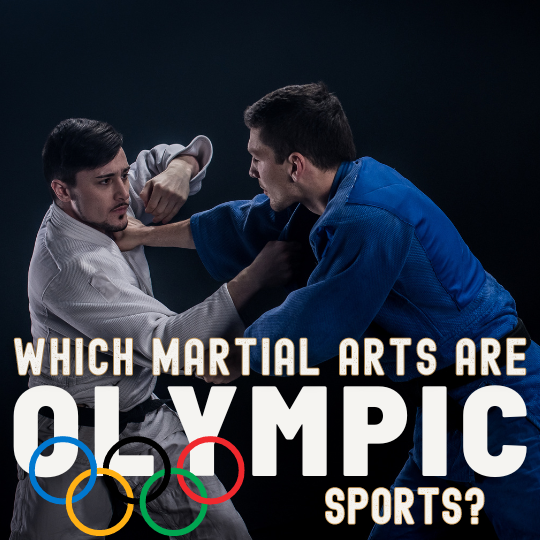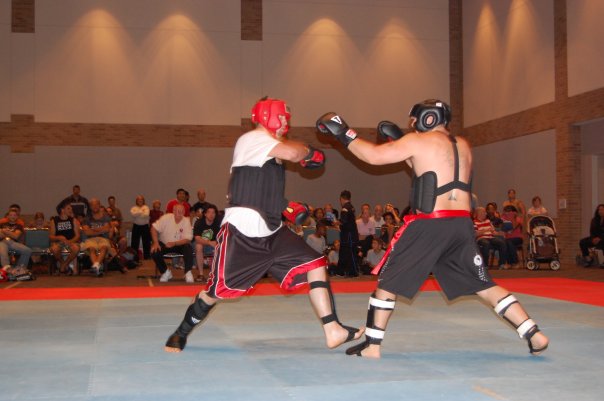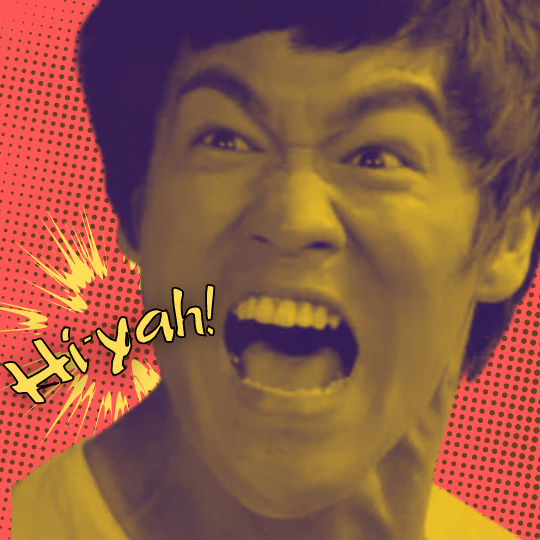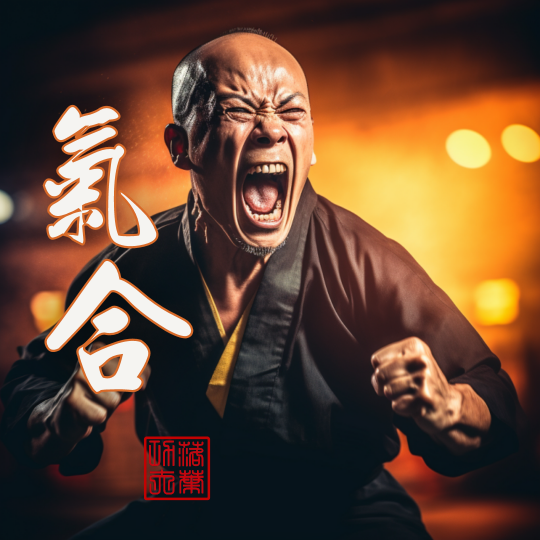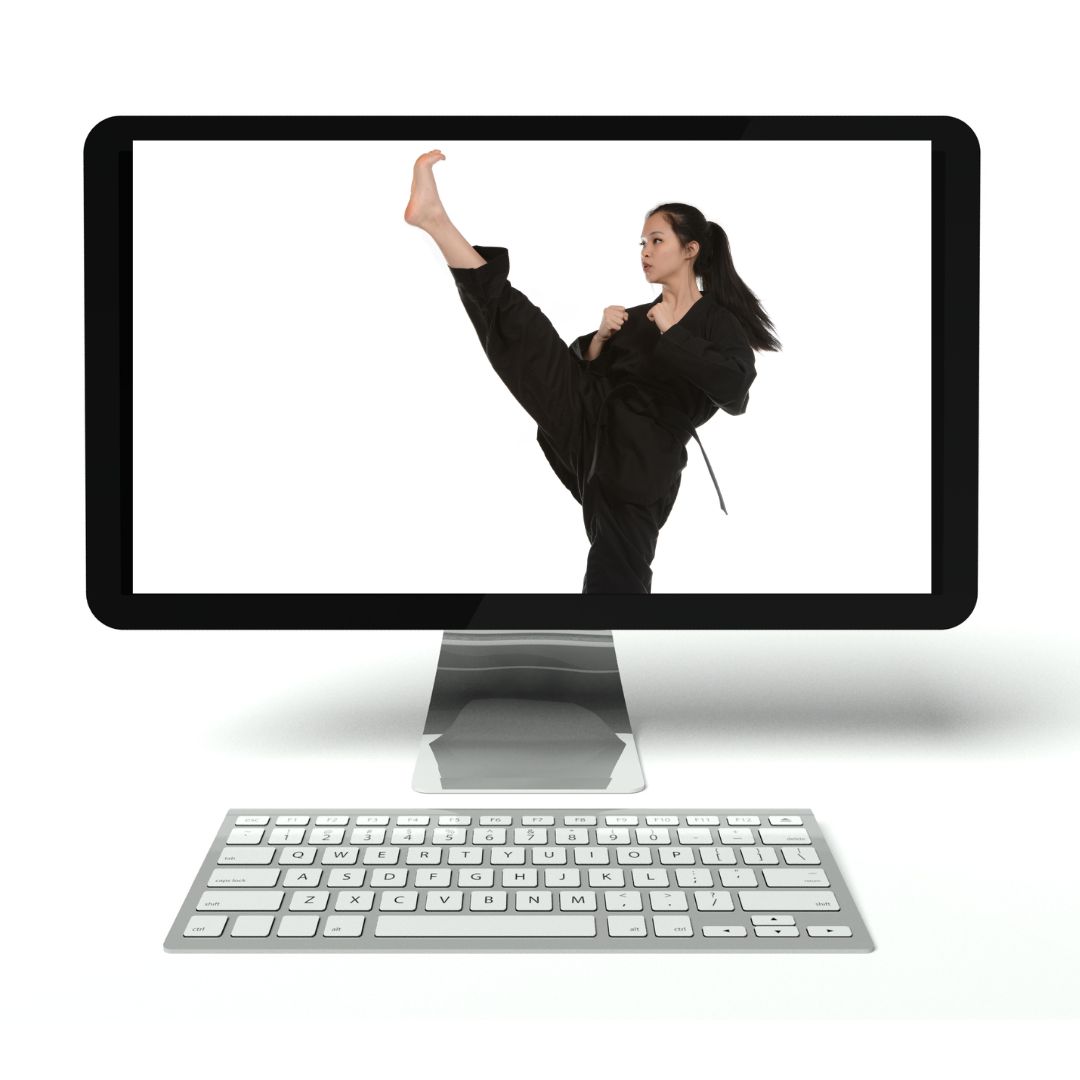
Many people wonder if martial arts can be self-taught. If you’re asking, “can I invent a martial art out of thin air, with no experience and no guidance?” then the answer is, of course, “no.”
However, I think most people mean, “can you learn a martial art online?” or perhaps, “can I learn a martial art at home?”
These are much more interesting questions with nuanced answers.
This article contains some affiliate links. I earn a commission if you make a purchase.
Key Takeaways
Benefits of Online Learning
- Distance is not a limitation
- Make friends with people from around the world
- You can learn at your own pace and rewind and review sections as needed.
- You can learn from the comfort of your own home.
Limitations of Learning Martial Arts At Home
- It may require the purchase of additional gear
- Touch Free
- No Training Partners
- It can be challenging to stay motivated

Before Learning Martial Arts At Home
Before reading any further, I advise you to complete the following exercise; take out a pen and paper and fill in the blanks:
“I would like to learn martial arts at home so I can ______, so I can _____.”
This simple exercise can help you find tremendous clarity on your goals and priorities regarding an online martial arts program. Clear goals and priorities can help you decide which program is right for you. (If any.)
If you answered, “I want to learn martial arts at home so I can learn to fight, so I can compete and win a bunch of trophies,” no online program can help you. Instead, you need to find a good coach near you and work with them regularly.
If you answered something like
- “I want to learn martial arts at home so I can learn something new that’s fun and interesting, so I can enjoy my free time in a way that is convenient for me.”
- Or “I want to learn martial arts at home because I’m interested in a certain style and there’s no instructor near me,” then keep reading.
New Possibilities
If there was a silver lining to the pandemic and lockdowns around the world, it opened people’s minds to the idea of taking online classes for things like martial arts or yoga.
Before the global lockdowns, companies like Peloton produced indoor cycling bikes and related services, including a streaming app with live and on-demand classes. The company was founded in 2012 and was already relatively popular. However, the 2020 global response to COVID left many with no option but to look online for ways to participate in a group fitness class and connect with others. The possibilities for people like me to offer our services online exploded.
But first, we need to be realistic. Learning martial arts online is not the same as learning directly in person, so naturally, there are some significant limitations and a few unique benefits.
This article will explore how you can learn martial arts at home. We’ll also look at some of the most significant limitations, how to work around them, and help you decide if our online classes (or someone else’s) are right for you.
Good Reasons For Martial Arts Zoom Classes?
There are many reasons why it might be difficult for someone to join a traditional dojo or gym. Many of these reasons are often work-related. For example, many people work nights or travel frequently, making it difficult to get to a gym consistently.
A great reason to learn martial arts online is that a particular instructor or style of martial art resonates deeply with you; however, there is no school nearby. This was the case for me in 2002.
After spending three years looking for an instructor that I felt was right, I met Prof. Em. Sam Chin, and there was no looking back. However, he lived in NY, and I live in AZ, so I have always been a remote learner. I will discuss some of the ways I managed to navigate the obstacles of remote learning in more detail below.
In 2002 it was very challenging; however, in 2022, there has never been a better time to learn remotely. Learning martial arts online may be the next best option if you want to learn a martial art but can’t join a regular dojo or gym.
Many websites and online courses can help you learn the fundamentals of martial arts from home. You can usually find videos and written instructions for specific techniques and exercises, as well as general information about the history and philosophy of the art.
You can find instructors and courses for almost any martial art style online, from Kenpo to Brazilian Jiu-Jitsu (BJJ).
Martial Arts Exercises You Can Learn Online
All martial arts have a variety of solo exercises which teach you the important fundamental movement patterns of the art and how to use your body most effectively and efficiently.
BJJ uses drills like “shrimping” while striking arts practice “shadow-boxing.” Chinese martial arts like I Liq Chuan have basic exercises to improve coordination and balance, as well as qigong, which improves health and strengthens the mind-body connection.
In Chinese martial arts, or “Kung Fu,” these fundamentals are referred to as jibengong 基本功. These “basic exercises” are essential to progress whether you’re learning in a group class or at home. They lend themselves very well to an at-home or online course.
What To Look For In An Online Martial Arts Class
When choosing an online class or instructor, there are several things to keep in mind.
First, ensure that the instructor is experienced and knowledgeable in the martial art style you’re interested in. Unfortunately, many so-called “instructors” do not have the proper understanding or training to effectively teach martial arts, especially online.
Second, ensure that the class is structured in a way that will allow you to progress effectively. A good online program will provide clear instructions, demonstrations, step-by-step progression, and regular feedback to track your progress.
The last point is crucial. Having access to pre-recorded content can be helpful. Still, if you want to make real progress, it’s essential to choose a program where you get to ask questions and get feedback in real-time.
I engage with everybody individually in my martial arts zoom classes. I assess their movement and understanding of the material and give them a chance to ask questions on anything that might be unclear.
Martial Art Is One Big Family

Without a doubt, the most important benefit of any martial arts class, whether in person or online, is the friends we make. My Sifu (teacher), Prof. Em. Sam Chin, is like a father to me, and many of my students have become some of my closest friends. In addition, I’ve met many amazing people through martial arts and had the opportunity to travel to many different countries.
Joining a martial arts Zoom class throws those doors wide open, allowing you to connect regularly with people worldwide. For example, my online course has students logging in from places like the US, Canada, and Germany.
For the whole first year of the pandemic, I Liq Chuan held daily Zoom classes as it was the only option for many students in Europe and worldwide.
Thankfully, we never really locked down here in Arizona. Yet, it was still a relief to join and sometimes lead those sessions, connecting with friends from all over during a stressful time and meeting some new members for the first time.
I Liq Chuan Zoom led by me during the pandemic
Learn At Your Own Pace
When you’re learning martial art at home or online, you can go at your own pace and pause or review sections as needed without worrying that you might be disrupting the class flow. This is a great advantage if you have a busy schedule or want to take things slowly at first. You can also rewatch videos or read through sections of written material as often as you need to understand the concepts thoroughly.
I Liq Chuan is based on Zen philosophy and Tai Chi principles. These concepts can be unintuitive or just downright confusing to Westerners, so learning at your own pace is very helpful.

Additionally, every martial art style uses specific terms and phrases to refer to different techniques or positions. Therefore, access to a glossary of terms and supplemental materials can shorten the learning curve dramatically, even if you take lessons in person.
That’s why everyone in my group classes here in Tempe also gets full access to the online materials, including over 30 hours of pre-recorded material. This library includes deep dives into the application of Zen philosophy to martial arts, how it can also apply to our daily lives, terminology, and basic exercises.
Learn Martial Arts From The Comfort of Your Own Home
One of the great advantages of learning martial arts at home is that you can do it without ever leaving the house. This means that you don’t have to commute to and from a dojo or academy, and you can train at any time of day that is convenient for you. When I was younger, I spent many hours training at midnight alone in my kitchen due to my work schedule at that time.
Additionally, if you have young children at home, this can be a great way to spend some quality time with them while also getting in your training.
Limitations of Learning Martial Arts Online
When practicing martial arts at home, you won’t have access to all the resources you would if you were learning at an academy or with a private instructor. This includes things like specialized equipment.
Here are a few items you may need to purchase for your home:
Read my full beginner’s guide to martial arts equipment for home here.

- a heavy bag
- some small folding mats if you plan to enroll in an online program for Brazillian Jiu-jitsu or Aikido.
Having equipment at home, like a heavy bag or a double-end bag, is excellent. However, they still don’t truly add a reactionary element to your training, like someone holding striking mitts or paddles for you.
This isn’t that important if your goal is to improve your fitness. However, getting supplemental coaching with a nearby trainer is necessary if you would like to develop some usable self-defense skills.
Most martial arts instructors like myself offer one-on-one appointments that you can book at a convenient time. Spending an hour with an experienced trainer online or in person is like spending 10 hours training alone when you’re just starting.
Motivation & Accountability
In addition to the lack of equipment mentioned previously, there are some other significant shortcomings when learning martial arts at home.
For example, if you want to learn martial arts at home, you must be very disciplined in your training. Letting time slip by without training can be very easy without others holding you accountable and motivating you.

Learning at home means setting aside regular time to practice and being willing to put in the hard work required to master the techniques. Without a sense of discipline, it will be challenging to make progress.
However, if you can find a friend or family member to practice with you, this can help. Regular training partners can also help you practice the material, identify what you don’t understand or what’s not working well, and ask your instructor questions.
No Touch
Lastly, the most significant limitation of learning martial arts at home or online is the lack of touch from your instructor.
In this sense, distance is still the most significant obstacle. Complex movement skills, like those found in martial arts training, absolutely require hands-on corrections to get them right.
In the so-called “internal martial arts” like I Liq Chuan, they must be “transmitted directly,” as we say. Your instructor must allow you to touch their body to “feed you” the correct feel.
For example, in I Liq Chuan, we talk about “fork energy.” Fork energy is a concept from our system that follows the principle of “one-to-two.” Fork energy means creating at least two different vectors of force from every point of contact. One direction of force is created by either pulling or pushing directly, and at least a second is made by rotation.
These are qualities you probably won’t be able to see easily on your screen and must feel to be truly understood.
Attend A Workshop
Suppose scheduling issues or other reasons prevent you from getting to the gym regularly. However, you still want to learn a martial art. In that case, most organizations hold regular workshops or clinics.

If you’re learning martial arts from home, you can attend a workshop three or four times a year. Workshops or clinics help reinforce the material you’ve been studying, and you can get hands-on corrections from a qualified instructor.
While your progress will be slower following this hybrid model, it still works quite well to ensure that you have a usable martial arts skill if that’s a priority.
Workshops are always great for connecting face-to-face with the friends you’ve made through training. Although your schedule might not accommodate getting on the mats regularly, most people can still carve out a few weekends per year.
Additionally, you’ll make rapid progress when you immerse yourself in the material for a few days. So attending a weekend clinic or a week-long training camp is still a good idea, even if you participate in regular group classes.
If you’re learning martial arts at home, it’ll give you new insights to take home to deepen your practice and hopefully train with a partner. In addition, sharing what you learned with others is one of the best ways to clarify and reinforce new material.
Summary

Martial arts cannot be entirely self-taught. At best, you’ll be reinforcing habits you already have, and at worst, you’ll be wasting your time with nonsense that has no practical application.
If you want to learn martial arts at home, you’ll need to find a good instructor online who can help spot mistakes you might be making and offer additional insights.
While Zoom-based martial arts classes can be convenient or help connect you with a remote instructor that resonates with you, by themselves, online lessons are incomplete. Therefore, you must supplement your online studies with periodic personal training, weekend clinics, or occasional training camps.
You may also need to invest in additional equipment, like a heavy bag, as joints and tissues need feedback from contact to adapt appropriately and use your skills effectively.
While everybody can benefit from learning martial arts online, zoom classes are best for
- someone looking for something new and exciting to do from home
- or intends to practice a particular style for a long time and periodically receive supplemental training in person.
The hybrid model was the model I followed as a distance student of Prof. Em. Sam FS Chin. It took me about three years to finally build up enough skill that other people were interested in training with me. That might seem like a long time, but it was tremendously rewarding in the long run.
I have made many close relationships and have been fortunate to see many new places. When I started out, I didn’t have nearly as many resources available to me as a remote learner as you do today. Today, it’s never been more feasible to learn remotely.
Join Us
Consider my weekly, live online class if you’re interested in learning martial art online. Replays are generally available for a week. I also have a private Discord server where you can ask questions between classes, connect with other students, and access additional materials.
My Zoom classes have no restrictions on how many people can participate with you. I want to help people start study groups for I Liq Chuan in their area.

 Martial arts offer numerous benefits to both the body and mind. Our articles explore these benefits in detail, providing insights into how training can help improve physical and mental health. Here are some of the highlights:
Martial arts offer numerous benefits to both the body and mind. Our articles explore these benefits in detail, providing insights into how training can help improve physical and mental health. Here are some of the highlights:



